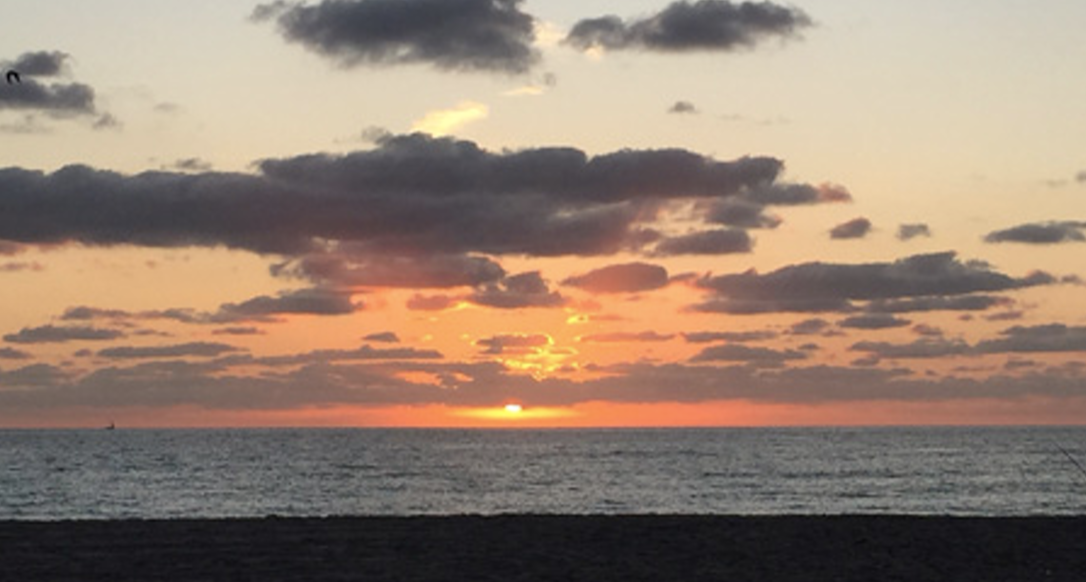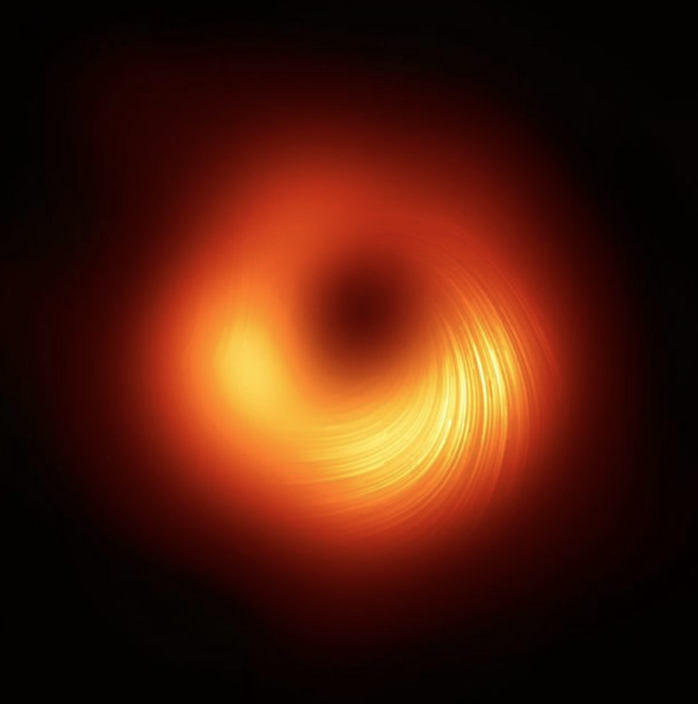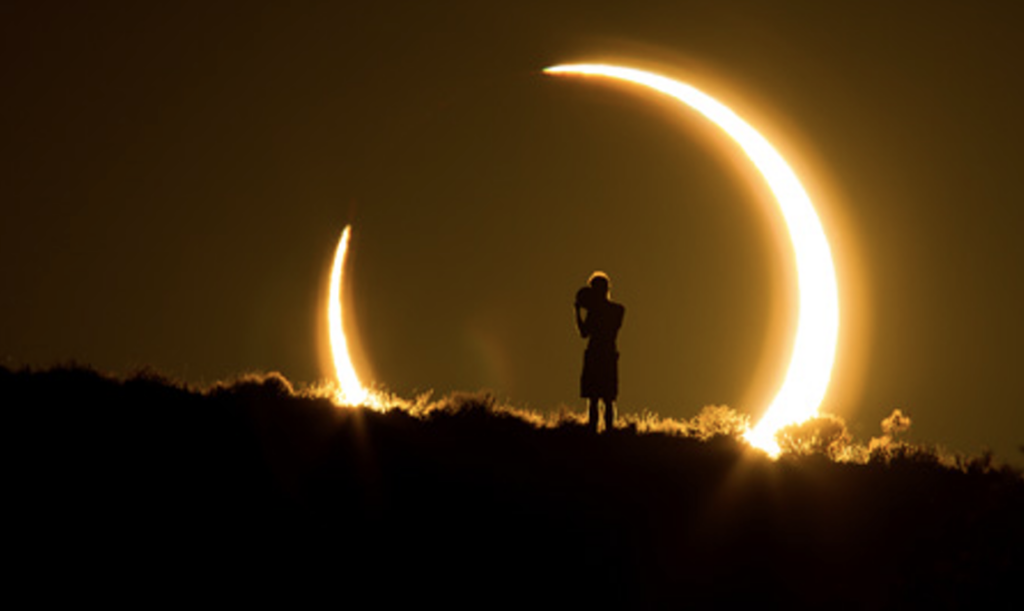Dennis Alan Winters
Tales of the Earth, Toronto, Ontario
gardens@talesoftheearth.com
What is it about Space that makes me feel so alive?
Calmly caresses?
Showers with boundless freedom infinite possibility?
Makes me EXPLODE with orgasmic euphoria?
What is it about Space that undermines grief washes tears & heals the hurt?
Helps dissolve the belligerent cacophony of negative emotions & perversities?
As a Buddhist & designer of places of refuge for spiritual renewal
How can I not know what Space is & what it is not?
&
The mechanism by which Space enriches the profound & everyday ways
of thoughts & doings?

Fig.1: Hollywood Beach, Dennis Winters, 2021
As my point of departure I thank Isaac Newton his Scholium his two allusions to Space —
His Relative Space — of discernable size shape measurement & dimension &
Absolute Space — invisible eternal & infinite attributes of Spirit 1
Of ideas of ‘Relative Space’ the Space with which we designers generally work—
I meditate on Space as one of the five operations of nature —
the container enabling the other four operations of Earth, Water, Fire & Wind to engage
Space #1
I meditate on Space as the natural complement of Form — of measurable size & dimension surrounding or surrounded by shape sound event number character or thought. Buddhists call this ‘space-form’2
Space #2
I meditate on Space as the forum for the interactive performance of things & thoughts in expressive & erotic patterns of motion & rest. Like Plato’s chora(χώρά), and Yi-Fu Tuan’s place, arena, field, property, site or region3
Space #3
I meditate on the Buddhist ‘Base of Infinite Space’. First of the four Formless Realms the ‘fourth degree of liberation’ the base of ‘peaceful abiding’. Projection of very subtle consciousness4
Space #4
The thing about these first three ideas of ‘Relative Space’ — Buddhist scriptures say they are among fifty-three ‘afflicted’ impermanent phenomena & along with the ‘Base of Infinite Space’ — are things & thoughts that will not lead me along a path of liberation prolonging the ‘suffering’ of cyclic existence.5 Causing me to question are these four apt explanations for the profound effect Space has on me?
I find myself quagmired in a struggle with contradictions because by their nature these ideas of relative Space are expressions of the two Buddhist philosophical truths — the nature of reality & reality of nature — to be ascertained & experienced right here & now. Hearing Muso Soseki, 14th century Abbot & designer of Kyoto’s first Zen gardens: —
“There are people for whom Space sustains their search for truth — this is truly noble, for there is no distinction between love of Space and a search for truth.”6
As a Buddhist & designer of places of refuge for spiritual renewal I engage the essential service of Space numbers one two & three in the everyday ways of thoughts & doings & the creative design prescriptions that profoundly link the landscape of Space with Spirituality presented in texts in which Space serves as creative expression of Divinity in its most beautiful & wondrous attire7
And then I meditate on Space the interstices of the cosmic web of gaseous hydrogen filaments that tie together the solar systems & galaxies spanning the universe formed in the fever of the Big Bang 13.8 billion years ago.8 The natural poetry of Einstein & Heisenberg’s unimaginable relatively uncertain expanse! Black energy Black matter Black holes Massive young galaxies creating disturbances in the Big Bang theory of origins Unbound wonder & reverence
“And suddenly, Neruda, he sees
the heavens
unfastened
and open,
planets,
palpitating plantations,
the darkness perforated,
riddled
with arrows, fire, and flowers,
the overpowering night, the universe.”9
Need we say engagement with Space is difficult to compute. William Shatner returning from Space his strongest feeling the one that dominated everything else he said was the deepest grief he’d ever experienced10
Would that be me for whom Space might also provoke bewilderment, fear & nightmares? Corrupt my sense of self-esteem with depression as I’d assume an unwarranted identity as an insignificant being engaged in an array of insignificant assignments on an insignificant planet of the universe?11 When this Space like the bewildered sense of self is too much to bear I’d harness devices to fill places with stuff time with activity & mind with thought to create a semblance of certainty familiarity & materiality
Engaging an ‘out-there’ to affirm a ‘me in-here’
“Space,” said William Blake, “is a state of mind.”12
Hearing Georgia for the sense of herself out there for the sense of life she feels: —
“Just nothing out there — the quiet & bigness of it — seems more like music than anything I’ve ever seen—this marvellously round trembling living thing — so much of it —loving it more than ever”13
Five meditations on Relative Space —

Fig 2: Messier Galaxy 87 Black Hole from Event Horizon Telescope, 2019, published The Astrophysical Journal
As a Buddhist & designer of places of refuge for spiritual renewal I meditate on ideas of ‘Absolute Space’ —
where engaging with Space is to behold Silence
&
beholding Silence is to engage Inner Luminosity
I meditate with Anaximander of Miletus [610-546 BCE] astronomer, geographer, philosopher his 2600-odd years ago search for the genesis of things & thought. Engaging Hesiod’s Theogony of supreme sky-gods thunder gods lightning gods & wind gods he eschews the traditional ideas of Divinity & transforms the revered role of the gods to the apeiron — the ‘boundless’ —
Space
as the first principle of Being
surrounding all and steering all
neither metaphysical nor transcendent
rather natural & real right here & now
immortal & infinite incorruptible, indestructible & inexhaustible
To Diogenes: — Anaximander’s apeiron is as Divinity permeating everywhere
To Aristotle in Physics: — Anaximander’s apeironis Divinity for it is immortal & indestructible14
I meditate with Plato [427-347 BCE] his 2400-odd years ago search for the genesis of things & thought — reveals Three Fundamental Divine Natures before the Demiurge sifts the constituents of earth, air, fire & water into their proper places —
[One] The ideal ‘Being’ an invisible, indivisible & intelligible consciousness, of neither beginning nor end
[Two] The created copy of the ideal ‘Becoming’ its arising, abiding & dissolving perceived by the senses
[Three] Space (χώρο — choro) The receptacle for created copies, enabling ‘Becoming’ a where in which to become Also, boundless & eternal unchangeable & indestructible. Apprehended only as if a dream or as the most subtle meditation. Sequestered neither in heaven nor earth yet always present15
I meditate with St. Aurelius Augustine of Thagaste (354-430 CE) Christian scholar & student of Plato & Plotinus as he seeks to reconcile his 1600-odd years ago trust in their respective insights into the genesis of things & thought. Per his Confessions he invokes a Trinity as if derived from Plato’s three natures —
Equating Plato’s divine ‘ideal’ with the ‘Father, of God’
Equating Plato’s ‘created copy’ of the ideal with the ‘Son, of God’
And through revelations into the infinite breath of life equates the Holy Spirit [pneuma] with the natural boundless rhythm of arising, abiding & dissolving of the exoteric & esoteric enabling things & thoughts of the profound & everyday a where in which to become — equivalent to Plato’s Divine Space16
And as a Buddhist & designer of places of refuge for spiritual renewal I meditate on Space of the three Buddhist Vehicles.17 In Pali & Sanskrit, this Space is ākāśa — ‘the mere lack of obstruction’18 —
Space
neither physical nor metaphysical
neither an ‘it’ a ‘thing’ a ‘this’ or a ‘that’
neither visible, measurable, dimensional nor directional
neither produced nor extinguished temporary nor perishable
inhibiting neither things & thought nor inhibited by things & thought19
The three Buddhist vehicles say the clarity of awareness is like Space. With the transformation of ordinary paroxysms of afflictive emotions into spiritual realization the landscape of attainment is like Space. The mind of a Buddha & Bodhisattva is like the stainlessness of Space & meditation on the stainlessness of Space is like meditation on the cessation of karmic causes & conditions & the cessation of ignorance. Meditation on the ultimate & relative nature of things & thought is like Space. Perfection of the mind is like Space & Nirvāņa is Space-like realization20
“The Bodhisattvas asked: — Where do the diamonds of Body, Speech & Mind dwell?
The Buddhas replied: — The diamonds dwell in Space.
The Bodhisattvas then asked: — Where dwells Space?
And the Buddhas replied: — Nowhere!
Then those Bodhisattvas, in wonderment and amazement, became silent”21
As a Buddhist and designer of places of refuge for spiritual renewal I meditate —
How could my engaging with Space
as expression & host of Divinity’s company
as substrate or genesis of things & thought
infinite & eternal immovable & unchangeable —
How could my engaging with Space
not be akin to my engaging with Divinity?
Then I ask
How could Space as Divinity
Divinity as Space
not be apt explanation for the profound effect Space has on me?
& then I ask
As Space as Divinity
By its nature is fundamentally unknowable What to do with this?
How to be open to it? Charged by it? Changed by it? — Would that be my task?
Hearing Rilke: —
“The space within us reaches out, translates each thing”
Space laughter of the supreme theophany
carriage of unbound reverence & wonder
fundamentally unserviced by ego, anger, jealousy, ill will, malice & pride embracing all things & thought without discrimination
Invites me to be the most nakedly
most luminous & knowing
to be alive
the most like Space
How liberating!

Fig.3.: Eclipse, photographer unknown
References
Saint Augustine. Confessions. Henry Chadwick, trans (Oxford: Oxford University Press, 1992) Charles Q Choi. “Faint Filaments of Universe-Spanning ‘Cosmic Web’” October 3, 2019 Edward Conze, trans. The Large Sutra on Perfect Wisdom (Delhi: Motilal Banarsidass, 1979)
Northrup Frye. Fearful Symmetry: A Study of William Blake(Princeton: Princeton University Press, 1947) Lama Anagarika Govinda. The Psychological Attitude of Early Buddhist Philosophy (New York; Samuel Weiser, 1974)
Sarah Greenough, editor. MyFarawayOne:SelectedLettersofGeorgiaO’KeeffeandAlfredStieglitz(New Haven: Yale University Press, 2011)
Andrew Gregory. Early Greek Philosophies of Nature (London: Bloomsbury Academic, 2022)
W.K.C. Guthrie. A History of Greek Philosophy, Vol I: Earlier Presocratics and the Pythagoreans (Cambridge: Cambridge University Press, 1962)
W.K.C. Guthrie. A History of Greek Philosophy, Vol IV: Plato The Man and His Dialogues: Early Period (Cambridge: Cambridge University Press, 2000)
W.K.C. Guthrie. A History of Greek Philosophy, Vol V: The Later Plato and the Academy (Cambridge: Cambridge University Press, 2001)
B. Jowett, trans. Timaeus, The Dialogues of Plato, Volume 2 (New York: Random House, 1937) Geshe Kelsang Gyatso. Essence of Vajrayana (London: Tharpa Publications, 1997)
Ronald Hepburn. “The Aesthetics of Sky and Space” in EnvironmentalValuesVol. 19, No. 3, (The White Horse Press, August 2010)
Jeffrey Hopkins. Meditations on Emptiness (London: Wisdom Publications, 1983)
Max Jammer. Concepts of Space: The History of Theories of Space in Physics, Forward by Albert Einstein (New York: Dover Publications, 1993)
Subhadra Jha. Abhidharma-kosaofVasubandhu.(Patna: K.P. Jayaswal Research Institute, 1983) Benjamin Jowett, trans. The Dialogues of Plato, Volume 2 (New York: Random House, 1937) Maurice Merleau-Ponty. Phenomenology of Perception (New York: Routledge, 2002)
Bhikkhu Nanamoli and Bhikkhu Bodhi, trans. TheMiddleLengthDiscoursesoftheBuddha:ATranslationof the Majjhima Nikaya. (Somerville: Wisdom Publications, 2015)
Pablo Neruda. “Poetry” in SelectedPoems(London: Penguin Books, 1975)
Isaac Newton. The PrincipiaI. Bernard Cohen & Anne Whitman, trans. (Berkeley, University of California Press, 1999)
Whitney Oates, Editor. Basic Writings of Saint Augustine, Volume Two (New York: Random House, 1948)
T. W. Rhys Davids and William Stede, editors. Pali English Dictionary. (Pali Text Society) https://obo.genaud.net/backmatter/glossology/glossology/akasanancayatana.htm
L. Poussin, L. Pruden, G. L. Sangpo, trans. Abhidharmakośa-Bhasya of Vasubandu(Delhi: Motilal Banarsidass Publishers, 2012)
Muso Soseki. Dialoguesina Dream. Thomas Yuho Kirchner, trans. (Somerville, Wisdom Publications, 2015) Yi-Fu Tuan. Space and Place: The Perspective of Experience (Minneapolis: University of Minnesota Press, 1977)
Kapila Vatsyanan, ed. Kalatattvakosa, Vol II (Delhi: Motilal Banarsidass, 1992) Alex Wayman. Yoga of the Guhyasamājatantra (Delhi: Motilal Banarsidass, 1980)
Notes
1 Newton, 1999: 408, 941
2 See Hopkins, 1983: 233-234
3 Not Χώρο (choro),meaning Space. See Guthrie, 2001: 262-264; and Tuan, 1977: 3, 138, 161
4 See Nāṇamoli and Bodhi, 2015: 457, 870
5 See Hopkins, 1983: 201-203, 217-218, 233-234
6 See Soseki, 2015. HIs reference is actually to ‘landscape’ of which ‘space is integral.
7 For a qualitative index for design and evaluation of landscape where experience of spiritual renewal and the spiritual nature of Space is component, see Buddhist Mahavastu and Vimalakirti Sutras; Plotinus’ The Enneads; Aristotle’s “Poetics;” Thomas Aquinas’ Summa Theologiae; Sakuteiki of Tachibana no Toshitsuna; Zoen’s Illustrations for Designing Mountain, Water and Hillside Field Landscapes.
8 See Choi, 2019
9 Neruda, 1975: 217
10 William Shatner interview by NPR one year after return space, October 13, 2021. See https://www.npr.org/2022/10/23/1130482740/william-shatner-jeff-bezos-space-travel-overview-effect
11 See Hepburn, 2010: 275; Govinda, 1974: 239-241
12 See Frye, 1947: 48
13 See Greenough, 2011
14 See Gregory, 2022: 32, 69-70, 108-110; Guthrie, 1962: 87-88
15 See Jowett, 1937: 12, 17, 28-32; Guthrie, 2000: 34, 116-117; Guthrie, 2001: 253-264
16 Augustine, scholar of Plato and Plotinus, was impressed and influenced by their works. Christian theologians infer the Trinity to have been derived from Plato’s three natures: the Father as intelligible pattern; the Son as imitation of the generation. My inference of Space as essence of the Holy Spirit requires extensive meditative investigation. See Oats, 1948: 104, 112-113; Augustine, 1992: 121, 276-280
17 Foundation Vehicle (Theravada), Perfection Vehicle (Mahayana) and Fruition Vehicle (Vajrayana)
18 See Rhys Davids and Stede. Ākāsā: [Sk. ākā.sa fr. ā+kā.s, lit. ‘shining forth’, the illuminated space].
19 See Vatsyanan, 1992: 93, 119; Jha, 1983: 13-14, 70-73; and Poussin, et al, 2012: I, 209
20 See Conze, 1979: 182-184; Hopkins, 1983: 217-219; Nāṇamoli and Bodhi, 2015): 529. Vajrayana consorts are called Space-dwellers and ‘awakening clear light ‘is synonymous with Space. See Gyatso, 1997: 178
21 See Guhyasamājatantra Chap XVII, p 139 referenced in Wayman, 1980: 312-313



